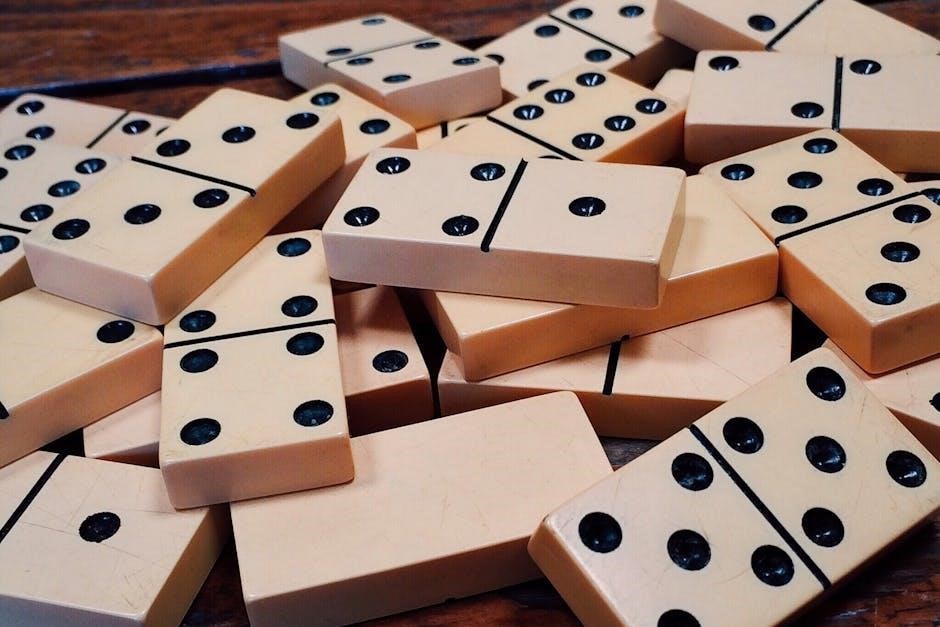Dominoes is a classic tile-based game with a rich history‚ offering simple rules and strategic depth․ Originating in China‚ it has evolved into various forms worldwide‚ appealing to all ages and cultures․ Easy to learn yet challenging to master‚ dominoes requires skill and foresight‚ making it a beloved game for 2-4 players using a standard set of 28 tiles․
History and Overview of Dominoes
Dominoes‚ originating in 12th-century China‚ has evolved into a global phenomenon․ Introduced to Europe in the 18th century‚ it gained popularity and transformed into various forms․ Traditionally made of materials like ivory or wood‚ dominoes consist of tiles with two ends‚ each marked with dots․ The game spread rapidly‚ adapting to cultural preferences‚ resulting in diverse versions․ Despite its simplicity‚ dominoes offers depth‚ requiring strategic thinking․ Its universal appeal lies in its accessibility‚ making it a favorite across ages and backgrounds․ The game’s enduring popularity stems from its ability to blend luck and skill‚ fostering both competition and camaraderie․
Basic Components of the Game
A standard domino set consists of 28 tiles‚ each divided into two ends with numbers of dots (pips) ranging from 0 (blank) to 6․ Each tile is unique‚ featuring combinations like 1-2 or 3-5․ Doubles‚ such as 4-4‚ are key in gameplay․ Players draw a set number of tiles‚ depending on the number of participants (7 for 2 players‚ 5 for 3-4)․ The remaining tiles form the draw pile․ Understanding these components is essential for learning the rules and strategies of dominoes‚ ensuring a smooth and enjoyable gaming experience for all involved․
Setup and Preparation
Players shuffle dominoes face down‚ each drawing 7 tiles for 2 players or 5 for 3-4 players․ Remaining tiles form the draw pile․
Number of Players and Domino Distribution
Dominoes can be played with 2 to 4 players․ For a 2-player game‚ each player draws 7 dominoes‚ while in 3-4 player games‚ 5 dominoes are distributed to each player․ The remaining dominoes are placed face down to form the draw pile․ Players must keep their dominoes secret‚ standing them upright to hide the pips․ This setup ensures fairness and prevents opponents from strategizing based on visible tiles․ The draw pile is used if a player cannot make a move‚ allowing them to draw a tile to continue playing․ This distribution method ensures balanced gameplay for all participants․
Shuffling and Drawing Dominoes
Before the game begins‚ all dominoes are shuffled face down to ensure a random order․ Players then draw their dominoes based on the number of participants․ In a 2-player game‚ each player draws 7 dominoes‚ while in 3-4 player games‚ 5 dominoes are drawn per player․ The remaining tiles are placed face down in the center‚ forming the draw pile․ The player with the highest double domino starts the game‚ ensuring a fair and strategic beginning․ This process ensures equal distribution and randomness‚ setting the stage for a competitive and enjoyable game for all players involved․
The Draw Pile and Starting the Game
The draw pile consists of the remaining dominoes after each player has drawn their initial set․ These tiles are placed face down in the center of the table․ The player holding the highest double domino starts the game by placing it in the center․ This double becomes the foundation of the domino chain․ Once the first domino is laid‚ players take turns playing their tiles․ If a player cannot play‚ they must draw from the pile until they can participate․ The draw pile ensures continuity and adds an element of unpredictability‚ keeping the game dynamic and engaging for everyone involved․

Objective of the Game
The objective is to be the first player to play all your dominoes or accumulate the most points by creating valid plays․ The standard target score is 100 points to win‚ though shorter games may use 50 points․ Players earn points by laying tiles strategically‚ ensuring they match ends correctly and maximize their scoring opportunities while minimizing opponents’․ The game requires a balance of skill and luck‚ making it engaging for players of all skill levels․
Scoring Points and Winning Conditions
Scoring in dominoes involves earning points by laying tiles that match ends with opponents’ open ends․ Points are tallied based on the dots left in the draw pile or on opponents’ hands․ The first player to play all their dominoes scores points equal to the sum of remaining tiles in other players’ hands․ The standard target score is 100 points‚ though shorter games may use 50 points․ If no player can make a move‚ the game ends‚ and the player with the lowest number of dots in their hand wins․ The goal is to strategically play tiles to maximize points and outscore opponents․
Game Length and Target Score
The game length varies depending on the target score agreed upon by players․ The standard target score is 100 points‚ though shorter games often use 50 points․ Each round ends when one player runs out of dominoes or no legal moves remain․ The player with the lowest number of dots in their hand scores points equal to the difference between their total and all opponents’ totals․ Multiple rounds are played until the target score is reached․ Tournament play may involve a best-of-three format‚ where winning two rounds advances a player to the next level․ The game balances simplicity with strategic depth‚ ensuring engaging gameplay․
Gameplay Mechanics
Players take turns matching dominoes by aligning numbers on open ends․ Doubles are placed crosswise‚ and chains form as tiles are added․ Strategic placement maximizes scoring potential․
Matching Dominoes and Forming Chains
Dominoes are matched by aligning the numbers on adjacent tiles‚ creating a continuous chain․ Players start by placing a tile that matches one end of the existing chain․ Each new domino must align with the open end of the last-placed tile․ Doubles are placed crosswise‚ and their open ends are counted until another tile is added․ The chain grows dynamically as players take turns‚ ensuring only one tile is added per turn․ This mechanic requires strategic planning and adaptability‚ as the chain’s direction and available matches evolve throughout the game․
Placing Doubles and Open Ends
Doubles are placed crosswise‚ and their open ends are counted until another tile is added․ Open ends are the unmatched sides of a placed domino‚ allowing players to continue the chain․ When a double is placed‚ both ends must match the adjacent tiles․ Players can strategically place doubles to control the flow of the game․ Open ends provide opportunities for future moves‚ and players must carefully plan their placements to maximize scoring potential․ Proper placement of doubles and management of open ends are critical for maintaining control and achieving victory in dominoes․

Scoring Methods and End of Round
Scoring in dominoes occurs when a player lays down all their tiles or no more valid moves remain․ Points are awarded based on the total dots left in opponents’ hands․ Each dot equals one point․ The round ends when a player runs out of dominoes or the draw pile is exhausted․ The winner scores points equal to the sum of their opponents’ remaining tiles․ In some variants‚ additional points are awarded for achieving specific conditions‚ such as laying the first or last tile․ The game continues until a player reaches the target score‚ typically 100 points or more‚ declaring them the winner․

Advanced Strategies
Advanced players focus on strategic planning‚ controlling the game flow‚ and reading opponents’ moves․ By anticipating future plays and maximizing point opportunities‚ skilled players gain a competitive edge․
Planning Moves and Controlling the Flow
Strategic players plan ahead by tracking tiles and anticipating future moves․ Controlling the flow involves setting up opportunities to play high-value dominoes while limiting opponents’ options․ By forcing opponents to draw from the pile‚ you gain an advantage․ Effective flow control also means maintaining flexibility‚ adapting to new plays‚ and keeping open ends to maximize scoring potential․ Planning moves ensures you can play all tiles efficiently‚ leading to victory․ This approach requires attention and foresight‚ making it crucial for advanced players seeking to dominate the game․
Reading Opponents and Maximizing Points
Experienced players excel by reading opponents’ moves and adapting strategies․ Observing which tiles have been played helps deduce opponents’ remaining dominoes‚ allowing informed decisions; By forcing opponents to draw from the pile‚ you limit their options and gain an advantage․ Maximizing points involves strategically playing high-value dominoes and creating scenarios where opponents cannot play‚ scoring points for leftover tiles․ Reading opponents’ tendencies and maintaining control over the game flow are critical skills for outsmarting competitors and securing victory․

End of the Game
The game concludes when a player reaches the target score or no more valid moves can be made․ The winner is the first to meet the winning conditions․
Winning the Game and Final Scoring
Winning the game occurs when a player reaches or exceeds the target score‚ typically 100 or 50 points‚ depending on the game’s agreed rules․ Final scoring involves summing the dots on all remaining dominoes in opponents’ hands․ The player with the lowest total score at the end of the round is declared the winner․ If no player reaches the target score‚ the game continues until a winner emerges․ The first player to meet the winning conditions is crowned the champion‚ and the game officially concludes․
Multiple Rounds and Tournament Play
Dominoes can be played in multiple rounds‚ with each round resetting the draw pile and starting fresh․ In tournament play‚ players compete in a series of games‚ often using a single-elimination or round-robin format․ Points from each round are cumulative‚ and the player with the highest total score at the end wins․ Tournament rules may vary‚ but the core objective remains consistent: score points by laying dominoes and outperform opponents․ The structure allows for extended competition‚ making dominoes a popular choice for organized events and casual gatherings alike․
Dominoes is a timeless game blending simplicity with strategic depth‚ accessible to all ages․ Its rich history and versatility ensure enduring popularity‚ while its rules provide a foundation for learning and enjoyment‚ fostering both social interaction and mental sharpness․
Dominoes is played with 2-4 players‚ each drawing 5-7 tiles depending on the number of participants․ The game starts with the highest double being placed first․ Players take turns matching dominoes by their pip counts to open ends on the table․ If a player cannot play‚ they must draw from the pile․ The goal is to be the first to play all dominoes or achieve a target score․ Points are scored based on the total number of pips left in the draw pile at the end of each round․ The game concludes when a player reaches the agreed target score‚ typically 100 or 50 points for shorter games․
Resources for Further Learning
For those eager to dive deeper into dominoes‚ numerous resources are available online‚ including official rule books and strategy guides․ Websites like Dominoes Rules and Dominoes Hub offer detailed instructions and variations of the game․ Video tutorials on platforms like YouTube provide visual explanations of gameplay mechanics․ Additionally‚ books such as “The Complete Book of Domino Games” and “Dominoes: A Comprehensive Guide” are excellent for advanced strategies․ Online forums and communities‚ such as Reddit’s dominoes subgroup‚ also offer tips and discussions․ These resources ensure players of all skill levels can enhance their knowledge and mastery of the game․
